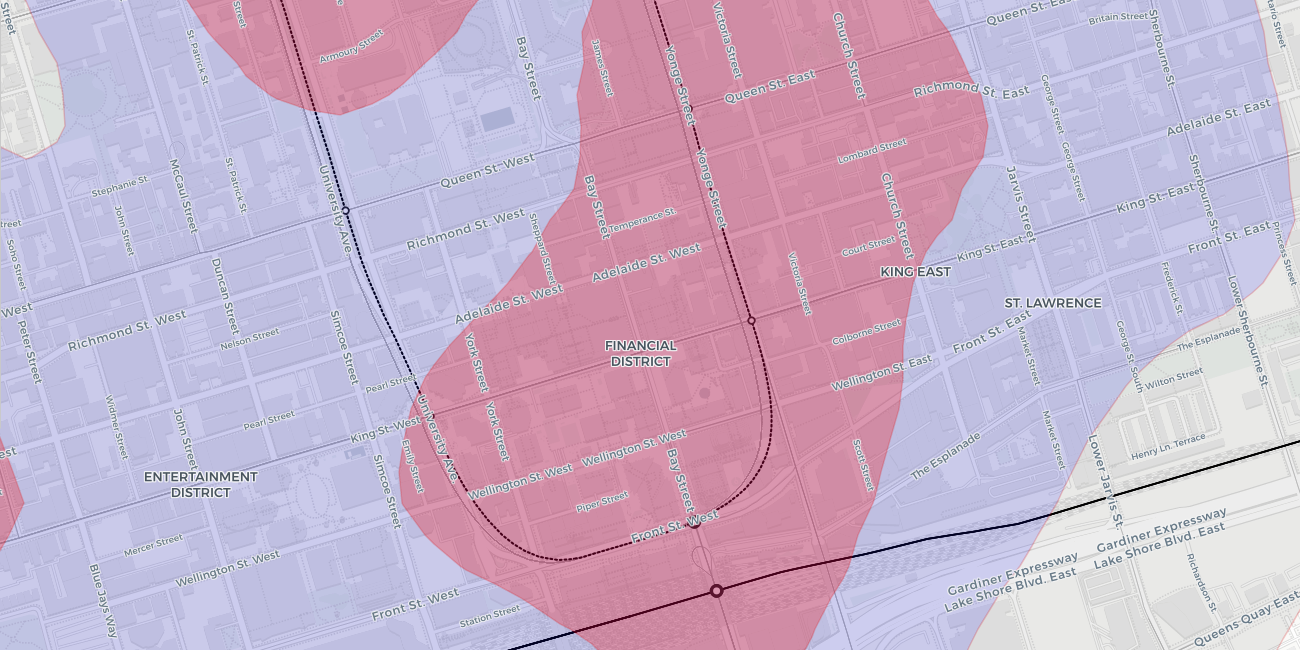Avoiding excessively long freight trips
Urban freight involves many kilometres of travel every day by small and medium-sized delivery vehicles. These vehicles, traditionally built with internal combustion engines, release large amounts of greenhouse gas and contribute to climate change by inefficiently burning fuel as they travel over long distances.
The existing urban freight system is not designed to minimize kilometres travelled, total lifecycle costs, or environmental emissions. Through policy strategies such as consolidating goods in urban hubs, optimizing delivery routes in time and space, and better managing the curbside in high density neighbourhoods, meaningful reductions in kilometres travelled can be achieved along with significant declines in emissions.
Time required to find parking and parcel pick-up and drop-off locations is an indicator of freight hotspots.
Parking time
The parking time data shows the average time commercial vehicles spend circling neighbourhoods to find parking. High parking times indicate stiff competition for curbside space and a need for better curbside management. Improved management will reduce fuel consumption by cutting the amount of time trucks spend searching for loading zones and parking, and it will reduce GHG emissions and congestion.
In the City of Toronto map, we see several, closely spaced parking time "contour lines" in the central core of the downtown — even during the COVID-19 pandemic when operations were reduced at office buildings. Commercial vehicles regularly circle blocks in the core of Toronto. Enhanced curbside management, such as pricing loading spaces in the Financial District and on King Street East, would reduce the time needed to find parking and loading spaces by prioritizing parking for commercial vehicles to load and unload quickly.
Parcel pickup and shipping locations
The pickup and shipping data show generic parcel origin or destination locations around the city, i.e., locations where one can pick up or mail a package either for personal or business purposes. This information reveals an opportunity to better integrate such facilities into mixed-use, multimodal mobility hubs (a transport node that connects multiple modes of transportation, such as consolidation micro hubs). This concept of consolidating packages at one pick-up location eliminates the need for delivery vehicles to make trips to multiple places to collect their loads, reducing time on the road.
Pricing loading spots and consolidating pick-up locations
Meaningful reductions in distance travelled and the resulting drop in emissions can be achieved through policy strategies such as consolidating goods in urban hubs, optimizing routes and stops in time and space, as well as pricing and better managing the curbside in high-density neighbourhoods.
Consolidating goods in urban hubs
Consolidation centres can centralize the shipment of goods prior to pick up for their next destination. This idea is being adopted in other cities; Paris, for instance, has the urban, multistorey, multimodal, mixed-use Chapelle International Logistics Hotel which opened in 2018. The Chapelle International Logistics Hotel is adjacent to a new residential neighbourhood. Sitting on a rail corridor and at 45,000 square metres, the facility has 11 tenants, including a delivery carrier operator.
Optimizing delivery routes and stops
Currently, delivery companies travel between consolidation centres — often located in suburban industrial areas — and the doorstep of the delivery destination. Urban traffic congestion in key corridors creates a situation that maximizes congestion and emissions and reduces productivity. Some cities have taken action to change this situation: extending delivery times through the night by enabling off-peak deliveries, for example. Peel Region, in the Toronto area, conducted a pilot project in off-peak deliveries with 14 retail locations of three large businesses. The results were promising as average deliveries were nearly 20% faster compared to deliveries made during the day. Moreover, GHG emissions per km dropped by slightly more than 10%, and other air pollutants were reduced in even greater quantities.
Pricing and managing the curbside
A full curbside means difficulty finding a parking or loading space, and delivery vehicles end up circling the area until they find a parking spot. To rectify this situation, for example, Washington, D.C., started pricing all its curbside zones. Commercial operators either pay with their phone or prepurchase annual or day passes to gain legal access to the loading zones. This resulted in a drop in passenger use and opened curbside zones for loading — reducing the need to circle the block and decreasing the associated emissions.

